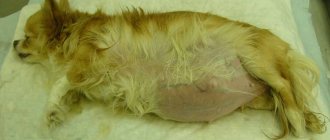Having got a girl dog, the owners, as a rule, want to get offspring from her. And what should you do if you have no experience, but you don’t want to harm your pet? But there is no need to despair. I think that after reading about the first signs of pregnancy in dogs and following her recommendations, you will understand that everything is not so scary.
The pregnancy of your beloved dog, especially the first, is an important period in its life. You shouldn’t be sure that your dog can cope with this on its own – after all, it’s inherent in it by nature. Never lose sight of the fact that your ward did not grow up in Spartan conditions at all, like her wild relatives, and she is not inherent in natural survival.
Signs of pregnancy in dogs
Nature arranges it this way that a dog can become pregnant strictly on certain days of the cycle - in the middle of estrus.
In healthy dogs, estrus occurs once every 6–8 months. The number of estrus depends on the breed and conditions of detention: actively working representatives of service breeds have one estrus per year. But on average, if reproduction is not limited, a dog can give birth to puppies twice a year. However, this is extremely harmful to the health of the animal and is irresponsible towards the puppies, who will be left without owners. The task of a good owner is to prevent unplanned pregnancies in his dog. The best way to prevent pregnancy is sterilization. Veterinarians sometimes recommend spaying dogs after their first heat. If this is your case, keep in mind that pregnancy during your first heat is quite possible. However, it will be difficult for the dog to bear healthy offspring. Bearing offspring and giving birth is a serious burden on an unformed body.
Estrus is a period when a dog behaves unpredictably, seeks the attention of relatives of the opposite sex, or, conversely, violently attacks them. To avoid trouble, be vigilant while walking. Never let your dog go for a walk without a leash. When kept in an enclosure, make sure that no other pet can visit your lady by climbing or jumping over the fence.
How to live with a pessary?
The gynecologist will definitely tell you what not to do after installing a pessary:
- to take a bath;
- swim in the pool and open water;
- squat and bend;
- lift weights;
- try to remove and adjust the ring yourself.
You will have to temporarily abstain from classical (vaginal) sex after installing a pessary.
After installing the pessary, you should adhere to the following tips:
- avoid physical activity;
- give up an active lifestyle;
- maintain bed rest;
- limit walks and trips;
- avoid stressful situations.
The obstetric pessary is removed when the due date approaches, at 37 weeks of pregnancy, or when labor begins prematurely.
How long does pregnancy last in dogs?
In theory, gestation lasts 56–68 days. In practice, puppies can be born on day 72. This is due to the fact that two planned matings are usually carried out, with an interval of 1–2 days, and fertilization can occur in the second mating.
For convenience, pregnancy time is divided into two months or three trimesters. Trimesters are distinguished as follows: first (1–23 days), second (24–43 days), third (44–day of birth).
First signs and symptoms of pregnancy (first month)
In the early stages, it is impossible to determine by eye whether a dog is pregnant. But caring owners may notice changes in behavior - the pet becomes more affectionate, drowsy, and less active. Pregnancy can be reliably diagnosed using medications. 21 days after the act, a pregnancy test is performed - a blood test for the hormone relaxin. The longer the pregnancy, the higher its level. At the same time, the placenta is formed and the fetal membranes are visible on ultrasound. But the best time to perform an ultrasound is the 25th day. The veterinarian will then hear the puppy's heartbeat through a stethoscope. Approximately 22-26 days after mating, the veterinarian can feel the future puppies.
What to do after determining pregnancy
DogWhat kind of pet do you have?Add a pet and get access to free consultations and advice!Cat
After the veterinarian confirms the pregnancy, he will select an individual observation plan for a specific dog. Veterinarians strongly recommend carrying out modern diagnostics of the pet and monitoring it during the entire gestation and not being content only with improvised means at home.
Throughout the entire period, it will be necessary to do ultrasound several times. And after the 40th day, using the same study, it will be possible to calculate the amount of time before birth. Also periodically take blood tests (biochemical and general clinical). And on the 40–42nd day, the veterinarian will recommend deworming to exclude intrauterine infection.
Next, all that remains is to wait for the upcoming birth, prepare the apartment space for the arrival of the puppies and talk in advance with the veterinarian about how the birth will be carried out and who exactly will do it.
And let the replenishment be happy!
What changes occur in the second month of pregnancy
The dog's belly enlarges, the mammary glands swell and darken, and viscous mucus may be released from the loop. The pet becomes less active and quieter, and its appetite increases. Starting from the 50th day, the puppies can be seen moving.
After 50 days of pregnancy, the female begins to look for a secluded place for herself and her puppies. Owners should monitor the nesting and find a cozy corner for the pet. If your pet's size allows, offer her a large cardboard box lined with moisture-absorbing diapers. Keep in mind that in such a “kennel” the dog will spend a lot of time with the puppies; there should be enough space for everyone. If necessary, trim one side to make it easier for your dog to enter his shelter. Be prepared for the fact that your pet will drag your “nest” to another, more convenient place for her. You'll have to come to terms with this.
Preparing for puppies
You want your dog's puppy to be as comfortable and comfortable as possible. The best way to do this is to install a puppy crate.
Puppy crates offer a safe, warm, comfortable, easy to clean place for your dog to have her puppies. Ideally, set up the puppy crate away from all other dogs and in a quieter area to give mom privacy.
Once you have purchased or built a puppy box, take time to get your dog used to it. Dogs are looking for warm, safe places to deliver their puppies.
If you don't introduce her to the puppy crate early, she may decide to take it somewhere else, such as your closet.
If you are breeding your dog for the first time, talk to your veterinarian about your role during the birth and read and educate yourself. Unless you plan to have an experienced breeder on hand, you will need to be prepared to intervene if necessary during the birthing process.
You'll want to gather the necessary puppies ahead of time so you have them on hand when your dog goes to work.
Caring for a pregnant dog
In a kennel, a pregnant bitch should be kept separately from others to reduce the risk of injury and miscarriage. From the 15th day, the development of internal organs in the fetus begins, so you cannot treat the dog for fleas, give anthelmintics, or vaccinate. Stress is eliminated as much as possible. It is worth limiting physical activity, especially in the second month, so as not to provoke a miscarriage.
Watch your dog carefully. If bloody, greenish, purulent discharge appears, consult a doctor immediately.
Of course, it is worth reconsidering the diet of the expectant mother. There is no need to overfeed the dog - by the time she gives birth she should gain 20-25% of her original body weight. Excess weight complicates the birth process; if the dog is underweight, it cannot bear and feed healthy offspring.
But you shouldn’t increase your diet from the first weeks of pregnancy to avoid obesity. In the second week after mating, there may be a decrease in appetite, and some dogs suffer from toxicosis in the early stages or simply eat less. In general, during the first trimester, the dog should eat as usual.
Active growth of the fetus begins already in the second trimester, from the 5th week. And the need for increased nutrition arises from 6–7 weeks, the need for protein, phosphorus and calcium increases. Be careful with calcium supplements. Both its deficiency and its excess are harmful for a pregnant dog and its offspring. Ready-made diets are already balanced in their content and there is no need to add additional minerals. When feeding with natural food, they are needed, but only a doctor will indicate the dosage.
In the last week of pregnancy, many dogs' appetite decreases; the portion can be reduced. Sometimes there are recommendations to reduce protein content. A day before giving birth, many dogs completely refuse to eat; this is normal and there is no need to worry about it.
Possible complications during pregnancy
Dogs can experience various complications during pregnancy. They are associated with disruption of the functioning of certain organs and systems.
Common complications also include the appearance of edema, which is a consequence of an unhealthy diet, as well as a lack of physical activity in the animal.
The most dangerous disturbances are during labor. It is quite difficult to predict their occurrence, but the help of a specialist will come in handy. Therefore, you should not delay contacting a veterinary clinic if the birth process is delayed or the owner has any doubts about the correctness of its course.
Timely contact with a veterinarian allows you to provide your dog with qualified care and preserve healthy offspring.
How and what to feed a pregnant dog
Of course, you need high-quality food, preferably super-premium or holistic. Its portion gradually increases starting from week 6, but quality in this case is more important than quantity. The food must be balanced in terms of the amount of proteins, carbohydrates, and fats. Proteins must be meat, not of plant origin. This is due to the fact that in an interesting position, a dog needs 40–70% more protein than usual.
Some brands offer special foods for pregnant women. The fact is that the dog’s need for food increases, but at the same time future babies put pressure on the stomach. That is, it is physically difficult for your pet to eat as much as it needs.
You can increase the dose of your usual food by adding one or two additional feedings per day. Such additional feedings are especially relevant in the last trimester, when the babies in the mother’s tummy have already grown significantly. Towards the end of pregnancy, the dog is fed 5 times a day.
Another option is to use puppy food. It is more "concentrated". It has a lot of protein, a balanced content of phosphorus and calcium. It’s easier for a dog to eat it without stretching its stomach. Depending on the size of your girl, this could be Acana Puppy Small Breed dry food for puppies and young dogs of small breeds or Brit Fresh Beef with Pumpkin for puppies and young dogs of large breeds. Carnilove Salmon & Turkey Puppy dry puppy food is suitable for all breeds. You can order these and other foods in our MasterZoo online store.
In any case, portions should be increased gradually. It is better to feed after a walk, taking a break of at least 30 minutes after returning.
When should you take your dog in labor to the vet?
It is better to initially give birth in a hospital if the male was larger than the female or if the female weighs less than 4 kg and if the pregnancy was difficult.
When to go to the hospital or call the vet:
- The vaginal discharge smells unbearably.
- Long pauses between puppies coming out (more than an hour and a half); before the doctor arrives, massage the dog’s belly with light movements.
- Temperature above 40 degrees (this is a sign of death of the puppy).
- Restlessness of the pet after childbirth, impaired coordination, seizures.
- Loss of consciousness.
- The prenatal period lasts longer than a day.
- The birth of a stillborn puppy.
- The last afterbirth doesn't come out.
You will be much calmer if you invite a veterinarian into your home with the necessary set of medications.
Medical and surgical termination of unwanted pregnancy
The information below is provided for informational purposes only. You should make any decisions only after consulting a veterinarian.
Interruption is far from a harmless procedure. It's safer to prevent pregnancy from happening. To prevent unwanted pregnancy after unplanned mating, a drug with the active ingredient estradiol benzoate is used. It is administered on days 3 and 5 from random mating. If the time of mating is unknown, then the drug is also administered on the 7th day.
If time is lost and pregnancy is confirmed, it can be terminated medically or surgically. This is an extreme measure, but sometimes it is necessary. There are situations where childbirth is highly likely to result in injury or death to the dog. For example, if pregnancy occurred during the first heat, the female has an abnormal pelvic structure, the mating happened to a very large male, etc.
For medical interruption, a special hormonal drug is used (active ingredient: aglepristone). The hormone disrupts the normal physiological process of maintaining pregnancy in bitches, which leads to abortion or fetal resorption. Valid for up to 45 days after mating. Termination of pregnancy occurs within a week after administration. Contraindications: individual intolerance; it is also prohibited to use in dogs with impaired liver, kidney and adrenal function, as well as in patients with diabetes. After taking the drug, the dog retains reproductive functions, and estrus occurs at the usual time. The downside is that when used after the 20th day, abortion may occur with physiological signs of labor - this can cause false pregnancy in the future.
The surgical method of terminating an unwanted pregnancy consists of an operation to remove the uterus and fetuses. After such an intervention, the dog cannot have puppies. A contraindication may be a weak heart or other conditions in which the dog is prohibited from anesthesia.
What could go wrong
Pregnancy doesn't always go smoothly. The first problems may arise during fertilization. Even with the correct mating technique and repetition twice, the female may remain unfertilized. In this case, you can repeat the mating with another male for the next cycle.
Complicated childbirth is not uncommon in small breeds, especially when the sizes of the female and male do not match. In this case, surgery will be required.
Pathologies of pregnancy
There are many pathologies and problems that arise during pregnancy. This depends on the compatibility of partners, hereditary diseases and sudden exacerbations, infections, physical activity and injuries. It is important to monitor the female’s condition and regularly show her to the veterinarian.
Frozen pregnancy
With this pathology, the development of one or more embryos freezes. A particularly dangerous phase is the 3rd week , when the main skeleton and muscle mass are formed. In this case, the body will try to get rid of the unnecessary element through miscarriage, resorption or decomposition of the embryo.
Symptoms may manifest as characteristic purulent discharge and pain, or may not even bother the female . If only one puppy stops developing (with a massive litter), then the pregnancy will continue. It is important to have your pet examined by a veterinarian and remove any remaining fetuses from the uterus to prevent rotting.
Ectopic
It may be a consequence of a disruption in the functioning of the endocrine or reproductive system of the bitch or an injury to the abdomen (the uterus ruptures and the embryos enter the abdominal cavity). Symptoms : blood and mucous discharge from the genitals, pain, internal bleeding. Pregnancy is terminated through surgery or medication (in the early stages).
Miscarriage in a dog
Removal of a dead fetus from the mother's womb. The reasons can be very different: infectious diseases (Brucellosis), poor-quality feeding, poisoning, injury, hormonal imbalance.
Symptoms : severe bleeding from the genitals, removal of the remains of the placenta, dead excreted fetuses near the mother. It is not recommended to touch or clean the female with bare hands. With an infectious disease, there is a risk of becoming infected. It is important to take your pet to the hospital immediately.
False pregnancy
Occurs 2-2.5 months after the last heat . It can be caused by internal harmonious imbalance, pathologies of the reproductive system, and psychological abnormalities. False pregnancy is exactly like a normal pregnancy with symptoms: toxicosis, swollen nipples, possible lactation, lethargy.
The consequences of such a deviation can be sexually transmitted infections, purulent mastitis, and poor-quality formations in the uterus and mammary glands.
Pregnancy always brings with it a lot of trouble; the owner will have to radically change the rhythm of life for the next 3-4 months. But for the sake of healthy, strong puppies, it is worth working hard, paying due attention to the mother, showing care and patience.
5 / 5 ( 1 voice )
Signs indicating that labor is approaching
After 50 days have passed from the moment of mating, it is recommended to measure the dog’s temperature twice a day. 18–24 hours before birth, the temperature drops by 1–1.5 degrees. A day or two before giving birth, your dog may have light brown, greenish or whitish discharge. A laboratory test for progesterone can confirm the approach of labor - it decreases significantly. Some dog breeds, such as English bulldogs, toy breeds, and mastiffs, have difficulty giving birth due to their build. There is a high chance that they will need the help of a veterinarian. Of course, the doctor should be familiar to the dog and not cause negative emotions in it. She doesn’t need any extra stress during the birth process.
Precursors of labor: • the mammary glands swell, in some cases, colostrum may be released; • the abdomen increases in volume, this is especially evident in dogs that have already given birth and in multiple pregnancies; • body temperature decreases; • the dog’s behavior changes – it looks for a secluded place, gets worried.
After severe abdominal contractions, the dog's water breaks. On average, 30 minutes after this, the first calf is born. As a rule, the four-legged mother immediately breaks the placenta, gnaws the umbilical cord and intensively licks the puppy. If she does not do this, the owner must help the baby.
After giving birth, it is better to offer the dog wet food, possibly diluted with warm water. Dry food may be difficult for your dog to chew during this period.
Postpartum period
Within 2-3 weeks after the removal of the placenta, the dog continues the postpartum period - involution or reverse development of changes in the genitals, endocrine, nervous, cardiovascular and other systems that occur in a dog during pregnancy. Additionally, as a result of lactation, the function of the dog’s mammary glands increases. The configuration of the dog's abdomen remains the same. The vulva and vestibule of the vagina take on the same appearance as before pregnancy. Swelling occurs, pelvic ligaments thicken, the uterus contracts and flattens to 1-1.5 cm (in large dogs), decreasing 10-15 times with the release of lochia (remnants of fetal fluid, blood, epithelial cells, uterine gland secretions) within 12-13 days. The cervix closes after the uterus is cleared of lochia. In the ovaries, degeneration of the corpus luteum of pregnancy occurs, and then the maturation of follicles. With poor feeding and maintenance of females, with a lack of walks, the processes of involution of the genital organs can be delayed, as a result of which various postpartum diseases are possible (acute postpartum endometritis in small domestic animals, salpingitis, etc.).
Useful tips
- Feed your dog properly during pregnancy (expensive food for pregnant and lactating dogs or natural food with added vitamin supplements).
- Maintain your dog's hygiene during pregnancy and childbirth.
- Dead (?) puppy. The puppy may be born lifeless. Don't give up. Just gently and actively rub it with a clean towel and quickly remove the mucus from the nose and mouth with gauze, massage the chest, and rub it upside down. Gently open his mouth slightly. Do everything to make the puppy squeak.
- If your doe's milk supply is low, start giving her dairy products in large quantities.
- Puppy without a bladder. You need to quickly clear the airways by sucking out the mucus with your mouth.
- The umbilical cord should be cut immediately to prevent the formation of an umbilical hernia in the baby.
- It is necessary to change diapers after each puppy.
- It is important to place the firstborn with the bitch as soon as possible so that he begins to suck milk. This stimulates the birth of the remaining puppies.
- The puppy must defecate, starting the digestion mechanism. If this does not happen, massage his abdomen and anus with a piece of wet cotton wool.
- After each walk, treat the mother's nipples.
And the last piece of advice: never give your dog medications without the presence of a veterinarian to avoid the death of the dog.
Be as sensitive, attentive and collected as possible, and then you will have wonderful, healthy puppies. Your dog will reward you with devotion, love and endless trust.
R-research
The study using an X-ray machine is carried out for a period of 56-58 days. This action is necessary to accurately determine the number of puppies and their location in the female’s uterus. Many owners believe that the examination is dangerous for the expectant mother and babies. However, doctors do not carry it out constantly; once is enough to find out the necessary information.
It is important to know the position of the puppies in order to eliminate the risk of various problems during birth.
Towards the end of pregnancy the belly is very noticeable
Relaxin test
Relaxin is a hormone that is produced in the dog’s body by the placenta of fetuses. It is a bit similar to human hCG and allows you to determine if an animal is pregnant.
The study should be carried out only at least three weeks after mating. Tests taken earlier will not give an accurate result. The ideal period is 24-26 days. In order to take a relaxin test, no special preparatory steps are required. The doctor will take blood for testing and then announce the results in detail.
Important! The test must be taken in the morning; the animal must not be fed beforehand.
Unfortunately, even such a test has some drawbacks. With its help it is impossible to determine the number of fruits. In addition, in case of spontaneous resorption or miscarriage, the results of such an analysis may remain positive for approximately 21 days, which provides unreliable information.
Veterinarians recommend conducting such a study at least a couple of times at intervals of a week. It is also worth undergoing other examinations to establish a more accurate diagnosis.
Why does the owner need to know the symptoms of pregnancy?
Every owner needs to understand the signs of a dog's pregnancy. The fact is that mating can happen by accident. Often the female is able to break loose and run away during the period of estrus. In this case, one can only guess whether she met a male along the way and whether she was able to get pregnant.
Symptoms of pregnancy in dogs do not appear immediately
Planned mating also sometimes does not result in pregnancy, so it is important to identify some symptoms that will confirm a positive or negative result.
Modern diagnostics
Finding out on your own whether a dog is pregnant after mating is quite difficult. It is recommended to contact your veterinarian if any changes appear. A set of diagnostic measures carried out by a specialist will allow you to find out the exact answer to this question.
- The first thing he will do is conduct a palpation examination. At this stage, even he will not be able to make an accurate verdict, since there is a high probability that he will confuse the interesting situation with an intestinal disorder.
- In the second trimester of pregnancy, he will be able to listen to the dog through a stethoscope. The presence of heartbeats in the uterine cavity is the surest sign of pregnancy.
- After conception, a hormone is actively produced in humans - hCG, and in dogs - relaxin. Another type of diagnostic test is a blood test. It will reach the desired value only on the 28th day after conception.
- Of course, the most accurate answer can only be given by the result of a diagnostic examination (ultrasound or x-ray). It will reveal whether there is a fetus in the uterus. It will grow to visible size on the 16th day after conception. For this procedure, you will have to cut the hair from the dog’s belly and give it a sedative that is safe for its condition.
It is recommended to choose a qualified veterinary clinic that has modern equipment.
Pregnancy milestones
If you have a calendar where you record the days and progress of your Labrador’s pregnancy, you can mark these important dates in it:
- 15 days from the moment of fertilization - the formation of the internal organs of future puppies begins (from this moment on, the bitch cannot be vaccinated or given anthelmintic);
- 26 days - introduce restrictions on the physical activity of the expectant mother so as not to injure the babies;
- 30 days - active formation of small skeletons requires the addition of calcium to the diet;
- 35 days - it is worth increasing the diet by about 10% of the usual (most likely, the bitch will develop an appetite);
- 44 days - the diet needs to be increased by another 5–10% of the standard norm, the number of feedings per day should reach five;
- 48 days - set up a place for your pet where she can “make a nest” for the litter, show it to her (it is important that she likes the bed and feels comfortable in it);
- 52 days - the amount of calcium in the diet should be reduced to a minimum;
- 58 days - you can notice the appearance of milk when there is pressure on the nipple;
- 59 days—Labrador can go into labor at any time: measure basal temperature using a rectal thermometer.
Basal temperature is measured at rest, preferably immediately after waking up. Most likely, this will not cause problems, because at a significant stage of pregnancy (right before giving birth) the Labrador bitch already needs almost constant rest and behaves passively. It is necessary to measure indicators in order to predict the time of labor: 24–48 hours before its onset, the temperature drops sharply to 36.5–36.8 °C. The drop in temperature only lasts a few hours, so take it often and record the results so you don't miss a beat and are ready to accept your puppies.
If within two days from the moment of observing a jump in rectal temperature there are no signs of incipient contractions, you should urgently call your veterinarian. Induction of labor or caesarean section may be required.











